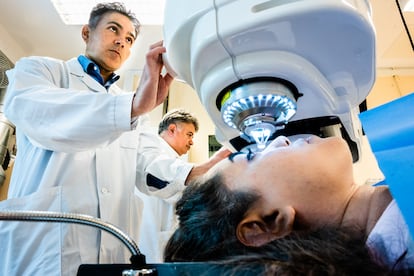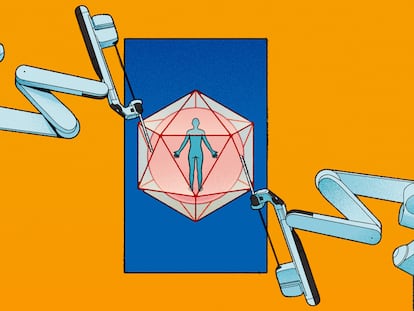Corneas made from pig collagen return sight to 20 people
A pilot study with bioengineered corneal tissue is paving the way for an alternative to human transplants

Corneal blindness occurs when the transparent membrane that covers the front of the eye and acts as a lens becomes opaque and prevents the light from reaching the back of the eye, inhibiting vision. It can be solved with a transplant, but experts estimate that 12.7 million people are currently waiting for a cornea donation. These membranes are in short supply: for every 70 that are needed, only one is available. In view of this problem, especially in countries where there are fewer donations of human corneas due to limited infrastructure, a group of Swedish researchers tested corneas made from pig skin collagen in 20 people who needed transplants (all of them Iranian or Indian citizens; 14 of them were blind). After two years, they all showed improvement, and those who were blind could see again. Although more complex clinical trials are still necessary to validate the measure, the first test of this bioengineered corneal tissue has proven to be safe. The results of this pilot study were published in the Nature Biotechnology journal.
There is also a socioeconomic aspect to corneal blindness: one million new cases are diagnosed every year, but according to researchers, most are concentrated in low- and middle-income countries in Asia, Africa and the Middle East – precisely where it is most difficult to obtain a donated human cornea, due to endless “economic, cultural, technological, political and ethical barriers.” Finding an alternative to the human cornea transplant is key, the authors point out, to fighting keratoconus, a disease that weakens and thins the cornea, and which is the reason for most transplants.
In order to find an alternative to donated human cornea, the researchers bioengineered collagen, the main protein in the human cornea, as a raw material. “For an abundant yet sustainable and cost-effective supply of collagen, we used medical-grade collagen sourced from porcine skin, a purified byproduct from the food industry already used in FDA-approved medical devices for glaucoma surgery and as a wound dressing,” they explain in the article. Unlike the human corneas, which must be used in less than two weeks, bioengineered corneas can be stored for up to two years.
The researchers also used a much less invasive implant technique than the usual one, which requires surgical sutures and can only be done in large hospitals. “A less invasive method could be used in more hospitals, thereby helping more people. With our method, the surgeon doesn’t need to remove the patient’s own tissue. Instead, a small incision is made, through which the implant is inserted into the existing cornea,” Neil Lagali, professor at the Department of Biomedical and Clinical Sciences at Linköping University and one of the authors of the study, wrote in a press release.
Sight improvement
During the two years in which the patients were monitored, no adverse effects or complications were observed. The results, the researchers point out, are similar to those of a human cornea transplant. Visual acuity improved; the tissue healed quickly and only eight weeks of immunosuppressive eye drops were needed to prevent the implant from being rejected. All the participants who were totally blind before the study partially or fully regained their sight.
“Safety and effectiveness of the bioengineered implants have been the core of our work,” said Mehrdad Rafat, CEO of LinkoCare Life Sciences AB, which manufactures the bioengineered corneas used in the study. “We’ve made significant efforts to ensure that our invention will be widely available and affordable by all and not just by the wealthy. That’s why this technology can be used in all parts of the world.”
Before reaching the market, this treatment will have to go through more tests to validate its effectiveness. “The results show that it is possible to develop a biomaterial that meets all the criteria for being used as human implants, which can be mass-produced and stored up to two years and thereby reach even more people with vision problems. This gets us around the problem of shortage of donated corneal tissue and access to other treatments for eye diseases,” explains Lagali.
The research published in Nature Biotechnology is a step towards ending the inequality in the access to corneal transplantation, but this is not the first time that attempts have been made to seek alternatives to donated human corneas: more than a decade ago, for example, Spanish researchers joined the race in search of artificial corneas made from the stem cells of a cornea extracted from a deceased donor. The fight against blindness is also taking place in the field of optogenetics, a gene therapy with photosensitive proteins that is already being tested in humans and has already managed to partially restore a person’s sight after 40 years of blindness. Research into the use of stem cells to cure vision loss also continues: preliminary studies have shown that grafting these cells into the retina does not cause rejection and allows incurable damage to be reversed.
Tu suscripción se está usando en otro dispositivo
¿Quieres añadir otro usuario a tu suscripción?
Si continúas leyendo en este dispositivo, no se podrá leer en el otro.
FlechaTu suscripción se está usando en otro dispositivo y solo puedes acceder a EL PAÍS desde un dispositivo a la vez.
Si quieres compartir tu cuenta, cambia tu suscripción a la modalidad Premium, así podrás añadir otro usuario. Cada uno accederá con su propia cuenta de email, lo que os permitirá personalizar vuestra experiencia en EL PAÍS.
¿Tienes una suscripción de empresa? Accede aquí para contratar más cuentas.
En el caso de no saber quién está usando tu cuenta, te recomendamos cambiar tu contraseña aquí.
Si decides continuar compartiendo tu cuenta, este mensaje se mostrará en tu dispositivo y en el de la otra persona que está usando tu cuenta de forma indefinida, afectando a tu experiencia de lectura. Puedes consultar aquí los términos y condiciones de la suscripción digital.










































